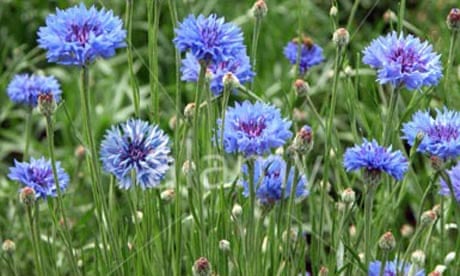I remember the cornflower garden in the street where I lived as a student. Among the bare, terraced houses, someone had sown a 3m x 2m drift of them. It was an oasis, a flash of cobalt blue that caught your eye from far off down the street. Everybody who passed would stop to stare at its unfussy beauty and very blue blue.
Cornflowers (Centaurea cyanus) are a UK native and once grew vigorously through our corn crops, patching the countryside with blue fields. But when farmers began using herbicides, they started to disappear and today are rare in the wild. They flourish instead in gardens.
They are the most splendid of annuals. Aside from their electric blue, which is breathtaking when they're grown in dense drifts, they are easy to grow, they flower all summer, they make great cut flowers, butterflies and bees adore them, and because you grow them from seed, they're cheap.
The other advantage is that they're a hardy annual, which means they can be sown very early in the spring or, 10 times better, now. Set off sometime in the next couple of weeks, the seedlings have time to establish before frost sets in. They will develop strong roots during the cool months, allowing them to form bigger plants – spring-sown cornflowers will reach up to 90cm, but autumn-sown plants grow to 1-1.5m and flower six weeks earlier.
They require a sunny, open spot and poor soil. When we think of cornflowers, we imagine running through vast fields of them, but you don't need a huge area to grow them: in fact, I've grown them in containers many times.
How to grow
You could mix cornflowers with other annuals, such as poppies, or sow them on their own. I like them mixed with hardy annual grasses (Thompson & Morgan does a great hardy annual grass seed mix). There are various cornflower hybrids in white, pink and red, but they never look quite right. The only non-blue variety worth growing is C. cyanus 'Black Ball', a deep burgundy cornflower that looks good with grasses.
Dig the soil, don't add fertiliser, weed and rake it over, removing any stones that might get in the way of the seedlings. If you're not sure what the seedlings look like, you may want to sow in lines to distinguish. In this case, with the edge of a handfork make grooves 6mm deep and 35cm apart, and place the seeds along each groove at 35cm intervals. Then run your hand over the area, so the sides of the groove fall in over the seeds. Alternatively, scatter the seed and rake it in.
Give the area a good drink. When the seedlings appear two to four weeks later, thin them out – each seedling needs 35cm of space around it. One advantage of sowing hardy annuals now is you won't have to water as much as you would in spring. But if it doesn't rain, keep the soil moist until they're established. The plants will need support or they'll look very drunk come June. Insert 1m hazel sticks around the planted area and lower two layers of mesh netting over them. They will grow through it and stand straight.
Cornflowers germinated at this time of year in the wild, so they should overwinter well. However, if we have a particularly cold winter, some may perish. If you're concerned about this, start them off in a greenhouse or buy them as plug plants in spring.
Just like sweet peas, cornflowers need to be cut constantly if you want them to flower all summer. Cut them just before they open fully – the centre of the flower should still be dipped inwards slightly.
Many people associate meadow planting with cornflowers, but in fact cornfield annuals such as cornflower and corn poppy last only one year in a permanent meadow. This is because they can exist only where soil is disturbed, which is why they grow in ploughed fields.
You can sow a wonderful annual meadow from scratch each year, either now or in early spring. It's easy to do and can be any size and any mix of hardy annuals. Mine is always simple: grasses and lots of cornflowers. Come May, I'll be gazing over a sea of blue.
Supplier: Cornflower seed and plugs are available by mail order from The Wild Flower Shop.
Seed offer
Order five packets of cornflower seed (two each of 'Dwarf Blue Midget' and blue 'Jubilee Gem', one of 'Black Ball') for £7.99, or 10 packets (four each of Dwarf Blue Midget and Jubilee Gem, two of Black Ball) for £10.98. To order, call 0844 573 2020, quoting ref GUA551). Delivery within 28 days.
